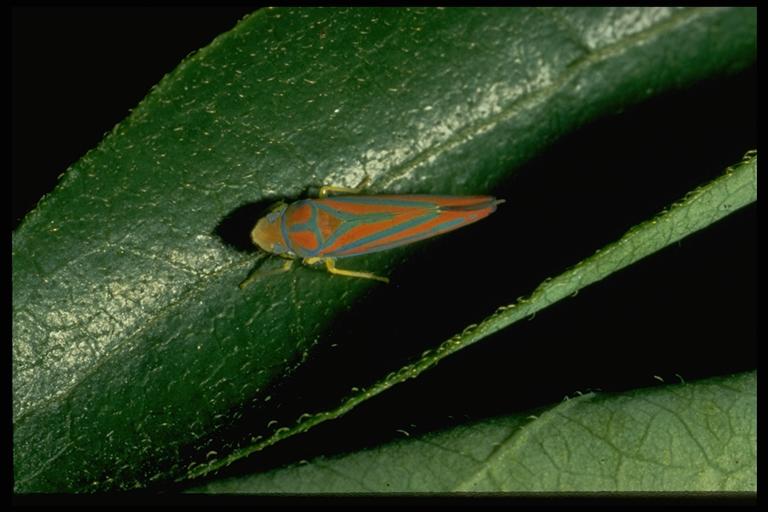
A leafhopper, Graphocephala sp. (Homoptera: Cicadellidae). Photo by C. L. Barr.
Common Name: Leafhopper
Scientific Name: Varies
Order: Homoptera
Description: Leafhopper adults are elongated, wedge shaped and somewhat triangular in cross-section. They jump and fly off readily. Depending on species, they range in size from 1/8 to 1/2-inch and their bodies are colored yellow, green, gray or they may be marked with color patterns. Nymphs resemble adults but are wingless. They can run rapidly, occasionally sideways, and hop.
Life Cycle: Most species overwinter as eggs or adults. Eggs are inserted into leaf veins, shoots or stems of host plants. Wingless nymphs hatch from eggs in about 10 days and begin feeding on the tender new growth of their host plant. They develop through five stages (instars) over a period of 12 to 30 days, leaving shed skins in the feeding area. As nymphs grow larger, they develop wing pads. Most leafhoppers produce one generation per year, but some may develop up to six.
Habitat and Food Source(s): Species can be somewhat specific to certain host plants. As a group they feed on leaves of a wide variety of plants including many types grasses, flowers, vegetables, fruit trees, shrubs, deciduous trees, palms and weeds. The rose leafhopper, Edwardsiana rosae (Linnaeus), feeds primarily on plants of the rose family, although foliage of other woody plants (blackberry, Cornus, oak, Prunus, Populus, raspberry, Ulmus, Acer and others) serve as food. The potato leafhopper, Empoasca fabae (Harris), feeds on legumaceous plants like alfalfa, as well as on apple, birch, chestnut, maples, and others. Species in the genus, Erythroneura, feed on sycamore leaves, but also on apple, grape and willow. The aster or six-spotted leafhopper, Macrosteles quadrilineatus Forbes, feeds on vegetables and annual flowers and spreads the aster yellows virus to woody plants like periwinkle and Thunbergia species. Nymphs and adults feed on the underside of leaves. Some leafhoppers are readily attracted to lights.
Pest Status, Damage: Very common and various species feed (with sucking mouth parts) on the juices of a wide variety of plants; occasionally injuring plants and transmitting plant diseases; medically harmless although adult leafhoppers are capable of biting, temporarily producing pain.
Whitish cast skins from developing nymphs are commonly associated with an infestation. Removal of sap from the mesophyll or vascular tissues (phloem and xylem) and injection of toxic salivary secretions (e.g., proteinaceous fluid that clogs in the vascular tissues) during feeding activities cause leaves to develop yellow or clear stipples, spots or leaf portions that are visible on the upper leaf surface. Marginal chlorosis (yellowing) and necrosis (browning) of injured leaves is often called “hopperburn” or “tip burn.” Injured leaves can fall prematurely. Some species cause terminal growth of injured plants to become curled and stunted. Heavily injured plant parts or plants can die. Egg-laying habits can also cause some plant injury.
Management: Click here for cultural and biological control information.
For additional information, contact your local Texas A&M AgriLife Extension Service agent or search for other state Extension offices.
Literature: Borror et al. 1989; Brook et al. 1982; Johnson & Lyon 1988.